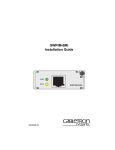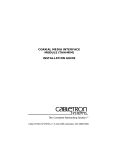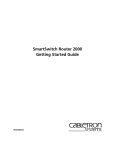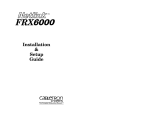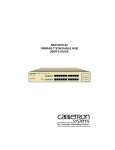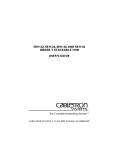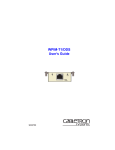Download Cabletron Systems MR-9000C User's Manual
Transcript
MR-9000C ETHERNET MULTIPORT REPEATER USER'S GUIDE CABLETRON SYSTEMS. The Complete Networking Solution™ CABLETRON SYSTEMS, P. O. Box 5005, Rochester, NH 03867-0505 NOTICE NOTICE Cabletron Systems reserves the right to make changes in specifications and other information contained in this document without prior notice. The reader should in all cases consult Cabletron Systems to determine whether any such changes have been made. The hardware, firmware, or software described in this manual is subject to change without notice. IN NO EVENT SHALL CABLETRON SYSTEMS BE LIABLE FOR ANY INCIDENTAL, INDIRECT, SPECIAL, OR CONSEQUENTIAL DAMAGES WHATSOEVER (INCLUDING BUT NOT LIMITED TO LOST PROFITS) ARISING OUT OF OR RELATED TO THIS MANUAL OR THE INFORMATION CONTAINED IN IT, EVEN IF CABLETRON SYSTEMS HAS BEEN ADVISED OF, KNOWN, OR SHOULD HAVE KNOWN, THE POSSIBILITY OF SUCH DAMAGES. Copyright April 1992 by Cabletron Systems Inc. P.O. Box 5005 Rochester N.H. 03867-0505 All Rights Reserved Printed in the United States of America Order number: 9030006-03 April 1992 LANVIEW is a registered trademark and MR-9000C, TMS-3, LAN-MD, and ST-500 are trademarks of Cabletron Systems, Inc. Ethernet is a trademark of Xerox Corporation NOTICE FCC NOTICE This device complies with Part 15 of FCC rules. Operation is subject to the following two conditions: (1) this device may not cause harmful interference, and (2) this device must accept any interference received, including interference that may cause undesired operation. NOTE: This equipment has been tested and found to comply with the limits for a Class A digital device, pursuant to Part 15 of FCC Rules. These limits are designed to provide reasonable protection against harmful interference when the equipment is operated in a commercial environment. This equipment uses, generates, and can radiate radio frequency energy and if not installed in accordance with the operator's manual, may cause harmful interference to radio communications. Operation of this equipment in a residential area is likely to cause interference, in which case the user will be required at his own expense to correct the interference. If this equipment does cause interference to radio or television, which can be determined by turning the equipment off and on, the user is encouraged to try to correct the interference by one or more of the following measures: e Re-orient the receiving antenna. e Relocate the MR-9000C with respect to the antenna. e Move the MR-9000C away from the receiver. * Plug the MR-9000C into a different outlet so that the MR-9000C and the receiver are on different branch circuits. If necessary, you should consult the dealer or an experienced radio/ television technician for additional suggestions. You may find the following Federal Communication Commission booklet helpful: “Interference Handbook” This booklet is available from the U.S. Government Printing Office, Washington D.C. 20402 - Stock No. 004-000-00482-5 il CONTENTS CONTENTS CHAPTER 1 INTRODUCTION 1.1 OVERVIEW ..................ee.oencccccoooceconoocrcaccaoo rene reee reee 1-1 1.2 GETTING HELP ..…..........….…oossseresensessesnsessassasssansersensassassaccen see 1-2 CHAPTER 2 SPECIFICATIONS AND REQUIREMENTS 2.1 SPECIFICATIONS .................cccccccccocococcccoccccacaneoacocacenancanarereneannea 2-1 General Specifications ...................eeeessccceccccoreccococeccoococecaraceocceneene 2-1 BNC Interface (Port 1 - 8)........................s00ccccccccoccocccoccoccararerrocaces 2-2 AUI Interface (Port 9) ........................eccccccccccoocececaccaceneaeeerecaceccanana 2-2 AUI Connector Pin Configuration .....................eeoorerecaccocecrereee.. 2-3 Power Supply ..................essccsscecececccccccecece reee eee eeocececerecereree eee 2-3 Environmental Requirements .......................sscocececcccoccecararececeneane 2-4 7:11:17 O 2-4 Service ...................ecococccccrceccececeeo eco ceceo rec eceracacecerceeeaeoccacerererecereenene 2-4 Physical ecanecara ener eceneceocecacecerececene 2-4 2.2 NETWORK DESIGN GUIDELINES ..................e.esccccccccrcccccconecos 2-5 2.3 SITE SELECTION GUIDELINES ...................e.e.eccocccccccccorecrococes 2-6 CHAPTER 3 INSTALLING THE MR-9000C 3.1 INSTALLING THE MR-9000C ...................ce.icecooronccorcacoroneneocenes 3-1 3.2 POWERING UP THE MR-9000C ......................ee.ec0ccccerncencnnnnos 3-3 CHAPTER 4 TESTING AND TROUBLESHOOTING 4.1 OPERATIONAL CHECKessrreren rer 4-1 4.2 USING LANVIEW ..................1mmmmmeeee es 4-3 iii CONTENTS ZU INTRODUCTION CHAPTER 1 INTRODUCTION 1.1 OVERVIEW The MR-9000C Multiport Repeater conforms to IEEE 802.3 specifications. It can connect up to eight thin-net Ethernet coaxial segments to a thick or thin-net cable segment. You can connect any combination of Ethernet Version 1, Version 2, and IEEE 802.3 equipment. The MR-9000C can * transmit re-timed data packets * regenerate preambles * extend collision fragments ® automatically partition problem segments * automatically reconnect non-problem segments The MR-9000C Multiport Repeater incorporates Cabletron Systems’ LANVIEW™ monitoring and diagnostic system. LANVIEW gives a visual indication of problems such as power failures, collisions, and cable faults. LANVIEW can alert you to a problem condition, and indicate the nature of the problem, which streamlines troubleshooting. > MR-9000C ... © recent wri LANVIEW™ xcva MULTIPORT ETHERNET, * E) coso IEEE 802.3 REPEATER Jam E mur CABIETRON 9 8 7 6 5 4 3 2 1 Terms. Page 1-1 INTRODUCTION 1.2 GETTING HELP If you need additional support related to the MR-9000C, or if you have any comments, suggestions, or questions concerning this manual, contact Cabletron Systems Technical Support at Cabletron Systems P.O. Box 5005 Rochester, N.H. 03867-0505 Phone: (603) 332-9400 Page 1-2 SPECIFICATIONS AND REQUIREMENTS CHAPTER 2 SPECIFICATIONS AND REQUIREMENTS 2.1 SPECIFICATIONS Listed below are the electrical and physical specifications of the MR-9000C. Cabletron Systems reserves the right to change these specifications at any time without notice. тот wen ‚ ® м, BE Cn og Вых e yes is TE e e Ta EE О ти Delay times Start of packet: Collision to JAM: Preamble Input: Output: JAM output: Minimum packet repeated: FAULT protection: (any segment in to all segments out) 1180 ns normal; 1450 ns max. 1060 ns normal; 1550 ns max. 40 bits minimum to a maximum of 64 bits. Packets that do not meet this range are discarded as runts or giants. 64 bits minimum (last 2 bits are 1, 1). JAM pattern (1, 0) is sent to all segments when one segment detects a collision. 96 bits including preamble. Packet fragments are extended using the JAM data pattern. Segment disconnect occurs after 32 consecutive collisions, or when a segment's collision detector is on for longer than 2 to 3 ms. FAULT protection resets automatically after one packet is transmitted onto the FAULT protected segment without causing a collision. Page 2-1 SPECIFICATIONS AND REQUIREMENTS Internal transceiver: Terminations: Grounding: обл Зы Ки в LIL & 627 Frequency range: RX and CP pair input impedance differential: RX and CP pair input impedance common-mode: Common-mode voltage range at RX or CP Pair: Input sensitivity at RX or CP pair: Waveform symmetry TX Pair: Output voltage into 78 ohms TX pair: Page 2-2 BNC receptacle, with gold center contact, for use with BNC type plugs and RG-58 thin-net cable. Cabletron Systems TMS-3 transceiver. Each segment is internally connected to a 50 ohm terminator. Each segment connector shield is internally connected to earth ground by the MR-9000C. This eliminates the need for grounding the segments connected to the BNC ports. 4 to 20 MHz normal; 5 to 15 MHz worst case. 78 ohms normal; 76 to 80 ohms worst case Greater than 20.0 ohms 0 to 30 volts normal; 0 to 5 volts worst case +/-100 mV normal; +/-75 to +/-150 mV worst case +/-0.5 ns normal; +/-1.0 ns worst case +/-900 mV normal; +/-550 mV worst case SPECIFICATIONS AND REQUIREMENTS 8 Logic Ref. +.) —- 9 Collision - 7 No Connection —+* . | _—10 Transmit - 6 Power Return —T”* ++— 11 Logic Ref. 5 Receive + —— |, ++—— 12 Receive - 4 Logic Ref.— |. *t——13 Power (+12VDC) 3 Transmit + + 1-4 Logic Ref. 2 Collision + + J—15 No Connection 1 Logic Ref. 15 Position D Type Receptacle Connector Shell Connected to Case Figure 2-1. AUI Pin Connections The MR-9000C power supply senses and automatically adapts to the input voltage and frequency. Input frequency: | 47-63 Hz 120 volts nominal: .3 A @ 120V normal; .5 A @ 90 to 130 V worst case 220 volts nominal: .15 A @ 220V normal; .25 A @ 180 to 264 V worst case Output Voltage: 12 Vdc normal; 11.5 to 15.5 Vdc worst case Overload protection Input: (1) 3AG 2 amp fuse (not user serviceable) Output: (1) 3AG 1 amp fuse (not user serviceable) Page 2-3 SPECIFICATIONS AND REQUIREMENTS Operating temperature range +5° to +40°C Non-operating temperature range -30° to +90°C Operating humidity 5 to 95% (non-condensing) Safety Designed in accordance with UL478, UL910, NEC 725-2(b), CSA, IEC, TUV, VDE class A. Meets FCC part 15, Class A limits. NOTE: It is the responsibility of the person who sells the system to which the MR-9000C will be a part of to ensure that the total system meets allowed limits of conducted and radiated emissions. ES. он service MTBF (MHBK-217D): > 20,970 hrs. projected MTTR: < 0.5 hr. Dimensions: 3.2H x 15.0W x 12.4D inches (8.13 x 38.1 x 31.5 cm) Weight: 7 lbs. Shipping Weight: 8 lbs. Page 2-4 SPECIFICATIONS AND REQUIREMENTS 2.2 NETWORK DESIGN GUIDELINES In general, if your network components meet 802.3 specifications, the MR-9000C will function correctly. Thick-net cable segments must be 50 ohm Ethernet type coaxial cable. Thin-net cable segments must be 50 ohm RG-58A/U type coaxial cable. Thick-net cable segments can be no longer than 500 meters (1640 feet). Cable segments that are shorter than the maximum length should be Ethernet standard length: 23.4, 70.2, or 117 meters. Note: Non-standard cable lengths can cause impedance mismatches, which cause signal reflections and data errors. Thin-net cable segments can be no longer than 185 meters (607 feet) in length. Terminate all cable segments with a 50 ohm terminator. A thick-net segment can have a maximum of 100 transceivers, spaced at least 2.5 meters apart. Transceiver cable taps should be placed on the black bands on the cable. (The bands are placed at 2.5 meter intervals.) A thin-net cable can have a maximum of 30 transceivers, spaced at least 0.5 meters apart. The BNC ports in the MR-9000C are connected to earth ground, eliminating the need for grounding the segments connected to the BNC ports. Warning: Cable segments that are earth grounded at more than one point on the segment can develop dangerous ground currents. For safety, only one end of any thick or thin-net segment should be connected to earth ground. Page 2-5 SPECIFICATIONS AND REQUIREMENTS NETWORK DESIGN GUIDELINES (CONTINUED) The transceivers that the MR-9000C will be connected to must have their SQE test function turned off. The AUT cable that connects the MR-9000C to a transceiver must be IEEE 802.3 type cable and must be 50 meters or less in length. From its source address to its destination address, a data packet may pass through a maximum of four repeaters and five cable segments. If you use five segments of cable, two of those segments must be inter-repeater links, that is, point-to- point cable segments with no taps. 2.3 SITE SELECTION GUIDELINES Before you set up your MR-9000C, be sure the selected site meets the following guidelines. The surface area must be at least 21 inches wide, 18 inches deep and 6 inches high. The site must be within 7 feet of an appropriate power outlet. The site temperature must be between 5° and 40°C. Temperature changes must be no greater than 10°C per hour. Page 2-6 INSTALLING THE MR-9000C CHAPTER 3 INSTALLING THE MR-9000C When you unpack the MR-9000C, verify that you receive the following: one 8 foot power cord e one cable support bracket e two 8/32 x .375 inch screws * three 6 inch cable ties The bracket, screws, and cable ties are used to support the cables. 3.1 INSTALLING THE MR-9000C Installing the MR-9000C is a simple process of attaching the cable support bar, plugging in the Ethernet cables to the appropriate ports, and then connecting the repeater to an AC power source. 1. Using the two 8/32 inch screws (3, Fig. 3-1), attach the cable support bar (2) to the repeater. 2. Put the repeater on the selected site. Be sure that the site meets the guidelines listed in Chapter 2. 3. Attach an AUI cable, no longer than 50 meters in length, to the AUI port (1) on the repeater. 4. Attach the other end of the AUI cable to an external transceiver. Refer to the applicable transceiver manual. CAUTION: You must disable the SQE Test function on the transceiver connected to the MR-9000C. A repeater interprets the SQE test pulse as a collision and sends out a JAM signal when it detects a SQE pulse. SQE induced JAM traffic can effectively disable your network. All Cabletron Systems transceivers have an On / Off switch for the SQE test function. | Page 3-1 INSTALLING THE MR-9000C 1. AUI Port 2. Cable Support Bar 3. Mounting Screws (2) 4. On/Off Switch Figure 3-1. Installation 5. Attach the cable segment(s) to the BNC ports 1 - 8. Note: The repeater BNC ports are internally grounded and terminated. If you do not attach a terminated cable segment to a particular port, that port’s FAULT LED will illuminate. To extinguish the FAULT LED, attach a 50 ohm terminator directly to the port’s BNC connector. A FAULTed port will not affect the operation of the other repeater ports. 6. Plug the power cord into the power receptacle located next to the On/Off switch (4) on the back of the repeater. 7. Plug the power cord into a wall receptacle. 8. Use the cable ties to provide strain relief for the cables and the power cord. Strap the cables to the cable support bracket located on the back of the repeater. Page 3-2 INSTALLING THE MR-9000C 3.2 POWERING UP THE MR-9000C When you turn on the MR-9000C, two LEDs on the front panel should illuminate: e The PWR LED (1, Fig. 3-2) indicates that the repeater 1s receiving power. о The XCVR PWR LED (2) indicates that the repeater is providing power to the transceiver connected to the repeater’s AUI port. ‘MR-9000C ... wr LANVIEW™ Xen MULTIPORT ETHERNET/ IEEE 802.3 REPEATER _ CaBIETRON SYSTEMS. Figure 3-2. Power Indicators JAM Some FAULT LEDs for individual ports may be illuminated as well. Though each port is terminated internally, the cable segments attached to the repeaters BNC connectors must also be terminated. If a port does not have a cable segment attached to it, you may want to connect a 50 ohm terminator directly to the port, to turn off the port's FAULT indicator. Page 3-3 INSTALLING THE MR-9000C Page 3-4 TESTING AND TROUBLESHOOTING CHAPTER 4 TESTING AND TROUBLESHOOTING This chapter contains a procedure to perform an operational check on the MR-9000C. It also explains how to use the LANVIEW LEDs to help troubleshoot network problems. 3.1 OPERATIONAL CHECK If you suspect that you have a problem with your MR-9000C, use this procedure to verify that it is operating correctly. Before checking the repeater, you should test each cable segment with a time domain reflectometer and verify that cable lengths and impedances are within IEEE and 802.3 limits. You can run the following tests with the repeater connected to the network. To perform the operational check, you need two Ethernet node testers. The following procedure uses Cabletron Systems’ LAN-MD node testers and ST-500 transceivers. 1. Connect one LAN-MD to the network as shown in Figure 4.1 1. ST-500 transceivers 2. MR-9000C 3. LAN-MD Figure 4-1. Operational Check Configuration Page 4-1 TESTING AND TROUBLESHOOTING 2. Select and run test 6, SERVER, on the LAN-MD. Once the test completes successfully, the LAN-MD acts as a server; it will echo packets when used with another LAN-MD. 3. Connect the second LAN-MD to one of the repeater BNC ports as shown in Figure 4.2. 1. вооон 3 pe 2. MR-9000C 3. LAN-MD Figure 4-2. Echoing Packets Through the Repeater 4. Select and run test 4, Node Check, on the LAN-MD that you connected in step 3. The Node transmits packets from one LAN-MD, through the repeater, to the other LAN-MD, where they are echoed and returned to the first LAN-MD. If you send and receive at least 100 packets with no errors, the repeater has passed the Node test. 5. Repeat steps 3 and 4 for each BNC port on the repeater. 6. Remove the LAN-MD that you connected in step 1. Page 4-2 TESTING AND TROUBLESHOOTING 7. On the remaining LAN-MD, select and run test 3, XCVR, On Net, to ensure that there is traffic on the network. 8. Remove a terminator from any of the segments connected to the repeater. The FAULT LED for that segment should illuminate. 9. Reconnect the terminator that you removed in step 6. 10. Check that the FAULT LED for that segment goes off. 11. Repeat steps 8 through 10 for each segment connected to the repeater's BNC ports. If the repeater passes all of the tests, it passes the operational check. 4.2 USING LANVIEW LANVIEW is a built-in diagnostic and monitoring system. Incorporated into the entire Cabletron Systems product line, LANVIEW lets you quickly scan a series of LEDs to get a sense of network activity and help you isolate physical layer problems. This section explains each of the MR-9000C LANVIEW LEDs. a N MR-9000C . 0 O 0000000 Ora wm LANVI XCVR MULTIPORT ETHERNET/ "* © couson IEEE 802.3 REPEATER = aw © rr CABLETRON 98 7654 3 2 15 SYSTEMS. J Figure 4-3. LANVIEW LEDs ED EEE LD raaeven go 1 LARES de Power (PWR) When lit, this green LED indicates that the MR-9000C is receiving power. The On/Off switch is located on the back of the unit, next to the power cord connection. EX a ; = FE e FEF EE VE PEE PU E veux ЗЕ SP “E VE YA ayer 4 X= Ed E 4 as dee AEB YE LLE EA LA E de A ARA When lit, this green LED indicates that the MR-9000C is providing power to the transceiver connected to port 9, the repeater’s AUI port. Page 4-3 TESTING AND TROUBLESHOOTING When this red LED flashes, the repeater is propagating a collision from the segment where the collision occurred, to all segments connected to the repeater. The repeater transmits the jam pattern (1,0) to all segments when it detects a collision on any segment. Receive (HECEIVE) This yellow I LED flashes when the repeater port receives data from the network. The LED flash is pulse stretched for viewing effect. Collision (COLLISION) This red LED flashes when the repeater port detects a collision condition or a jabber packet on the network. The flash frequency may increase as network traffic increases since more collisions are likely to occur. The LED is pulse stretched for viewing effect. sult (FAULT This red LED turns on when the repeater disconnects the segment from the network. The repeater disconnects a segment when 32 consecutive collisions occur on the segment or when the collision detector remains on for longer than 2 to 3 ms. The FAULT LED goes off (the repeater reconnects the segment) after one packet is transmitted onto the network without causing a collision. Page 4-4 POWER SUPPLY CORD The mains cord used with this equipment must be a 2 conductor plus ground type with minimum 0.75 mm square conductors and must incorporate a standard IEC appliance coupler on one end and a mains plug on the other end which is suitable for the use and application of the product and that is approved for use in the country of application. GERMAN: Die Netzleitung, die mit diesem Geraet benuetzt wird, soll eined zwei Leiter mit Erdleiter haben, wobei die Leiter mindestens 0.75 mm sind, mit einer normalen IEC Geraetesteckdose an einem Ende veersehen sind, der fuer den Gebrauch and die Anwendung des Geraetes geeignet und der zum Beneutzen im Lande der Anwendung anerkannt ist. SPANISH: El cable principal de la red eléctrica utilizado con este equipo debe tener 2 conductores y 1 toma de tierra con un minimo de 0.75 mm: cada uno y necesita tener un aparato de acoplamiento standard IEC en un extremo y un enchufe para el cable principal de la red eléctrica en el otro extremo, lo cual sea adecuado para el uso y applicatién del producto y lo cual sea aprobado para uso en el pais de applicación. FRENCH: Le cordon d' alimentation reliant cet appareil au secteur doit obligatoirement avoir deux fils conducteurs de 0.75 mm: minimum et un fil de terre. It doit égalament être équipé du cóte apparil d'une fiche agrée IEC et du cóte secteur, d'une prise adaptée a l'usage du produit et aux normes du pays u l'appareil est utilisé.
























